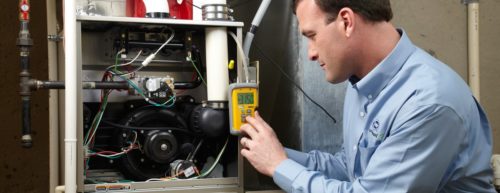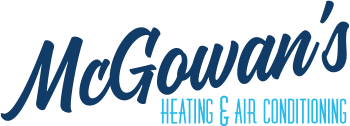
It’s discomforting when you want to run your furnace, only to be met with some unexpected noise. While your furnace will naturally make some sound as it runs, there are other noises that indicate you have a problem. Here are some of the most common noises you may hear from your furnace, and what they could be telling you.
Normal Furnace Sounds
Before discussing what the various noises from your furnace mean, it’s important to understand the normal noises. If your furnace is located in the basement, you may not hear most of these. However, it’s good to know just in case you’re nearby and something catches your attention.
The first noise that is very normal is a single clicking sound from your thermostat. This is actually your thermostat engaging, sending the signal for your furnace to start.
From there, you may hear a whoosh or a pop, which is the burner starting up. After the burner generates enough heat, your circulating fan will start, which will settle into a low hum for the remaining heating cycle.
With any of these sounds, your furnace should not disturb normal life around your home. If any of the noises get loud, regardless of whether they seem normal, you should have them checked out.
Squealing
Squealing is commonly associated with a problem with a fan motor. Every furnace has a circulating fan, and some furnaces have a draft inducer fan. These fans have ball bearings in them that allow them to easily spin and do their job.
When these bearings start going bad, they will oftentimes emit a high-pitched squealing sound. This is prevented by routine maintenance, where a technician lubricates the bearing to keep them turning freely.
In some models, especially older units, the fan is run by a belt, much like the radiator fan in a car. When the fan belt starts going bad, it loosens and starts slipping. If this starts happening, you’ll need a technician to replace the belt, and check to make sure the bearings are still good.
Banging
Banging may mean two different things, depending on when you hear it in the heating cycle. The less serious of the two issues is expanding and contracting ducts. Ducts are generally made of sheet metal, which will flex as they heat and cool, causing a banging sound throughout the house.
If you hear the banging sound at the start of the heating cycle, it is more likely a delayed ignition issue. The gas builds up in the ignition chamber. When it finally lights, it causes a small explosion, resulting in a banging sound. This can be a serious issue and cause substantial damage to your system and home if left unresolved. The best way to make sure you don’t have a combustion issue is to get routine maintenance for your system.
Scraping
A scraping sound is commonly associated with a problem with your blower motor as well. The most common concern that will cause this sound is failing ball bearings. Additionally, if your circulating fan wheel has come loose or is unbalanced, it may cause a scraping sound. When a technician maintains your system, they will not only lubricate the bearings but will also tighten the fan and ensure it’s properly balanced.
Rattling or Rumbling
The first thing a rattling sound may indicate is something having come loose in your furnace. This could be bearings in the blower motor, panels in your ductwork, panels on your furnace, ductwork connections, or a worn blower motor belt.
Less commonly, but more concerning, is a cracked heat exchanger. You may notice this rattling when your furnace first starts up, as it initially heats up. The metal in the heat exchanger starts to flex as it warms, causing the rattling sound as the exhaust moves through the system.
Because of the severity of a cracked heat exchanger, do not wait to have it inspected. This is part of what a technician will do during routine maintenance, part of why it’s so important for the health and safety of your family. A cracked heat exchanger is a primary cause of residential carbon monoxide leaks.
Humming
Depending on your furnace model, you may hear a quiet humming sound coming from your unit while it runs. However, a louder hum typically indicates you have one of several possible electrical problems.
A loud humming may indicate you have a faulty blower motor capacitor, which is used to start the motor. It may also signal a faulty transformer or a bad inducer fan motor. Another possible cause is an issue with your blower motor, including bad bearings. If you suspect any of these, it’s best to call a certified technician to troubleshoot and resolve the underlying issue before it causes more damage to your unit.
Whistling
Whistling is a very common occurrence with furnaces, and typically indicates a problem with air passing through the system. An airflow restriction causes more air to pull through a tighter space, leading to the whistling sound.
A clogged air filter is the most common cause of whistling within your system. To keep your system circulating air efficiently, plan to change your air filter regularly. The common 1- and 2-inch filters should be changed about every 90 days. Plan to check your filters monthly so that you catch clogged filters early, and gently vacuum them to help improve efficiency between changes.
Other issues that may cause whistling are airflow problems in your ducts. This may include clogs in your ducts, printable with periodic duct cleaning. It may also be damage to the ducts, allowing some air to push through the damage, causing the whistling sound.
Dealing With Unusual Noises
If you hear any unusual noises coming from your furnace, plan to get them checked out quickly. Small problems quickly add strain to your system, causing longer heating cycles and more components to fail. This means ignoring that whistling sound could mean substantial repair bills and increased utility costs when it could be solved with a simple air filter replacement.
Next, plan to get annual furnace maintenance to help prevent many common causes of unusual furnace noise. During maintenance, a technician will clean the heat exchanger and circulating fan, both of which are common areas for airflow restrictions. They’ll also tighten your circulating fan mounting hardware, and test each of the components in your system.
Your technician also does a deep dive into the internal components of your furnace. They’ll inspect your heat exchange and your combustion chamber to ensure everything is working properly. If they find anything unusual, you can repair the problem before it takes its toll on your system. This also helps prevent emergency calls in the dead of winter, when you depend most on your system to keep you comfortable.
People around Jacksonville have turned to McGowan's Heating & Air Conditioning for dependable heating and cooling solutions for over 40 years. Our team of NATE-certified technicians provides air conditioning and heating installation, maintenance and repair, along with a host of indoor air quality services. Call to schedule your furnace repair with one of our expert technicians today.



